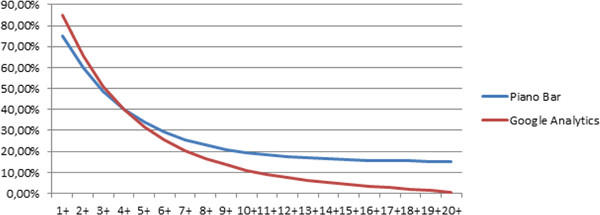How to optimize your ROI with marketing attribution
With the continuing increase in data volumes in companies, the diversification of online and offline contact points and the variety of user paths before purchase, it is essential to deploy multi-channel marketing strategies. But it is still important to be able to constantly measure the return on investment with a complete analysis of the financial impact and a relevant breakdown of the investments made on each marketing channel. Marketing attribution allows you to analyze the performance of all your marketing drivers at every point in the customer journey. Over time, you can reduce your acquisition costs by balancing your marketing mix and optimizing your ROI.
How do you calculate the return on investment of your marketing campaigns?
Before diving into your marketing ROI, we need to define precisely what we’re talking about.
What is marketing ROI?
The return on marketing investment is an index that measures the performance and profitability of your marketing operations based on a predefined objective. It evaluates the revenues generated by your marketing actions in relation to the investments made throughout the entire process. By tracking this indicator, expressed as a percentage, you can determine which campaigns are currently the most effective and successful. Marketing ROI helps you make the most appropriate business decisions at any given time and to better allocate your budget among your various acquisition channels.
Useful to know: You may also need to determine your Return on Ad Spend (ROAS) to estimate the financial returns of a campaign. Unlike ROI, which measures a net return on marketing investment, ROAS is based solely on the revenue generated by a specific ad or set of ads.
Which methods are used to calculate marketing ROI?
Before calculating the ROI of your marketing campaign, you must first define your objective(s):
- Generating traffic or leads?
- Converting new customers?
- Re-engaging "sleeping" customers?
- Collecting customer reviews?
Based on these objectives, you then determine key performance indicators (KPIs): open and click-through rates; number of visits or page views; volume of conversions (e.g., requests for demos or quotes); number of comments received and more.
The simplest formula to calculate the marketing ROI is to integrate the sales volume generated and the expenses invested in the campaign:
Marketing ROI = (Sales generated - Investment costs) / Investment costs * 100
But, to calculate your ROI, you can also use more specific performance indicators such as:
- Acquisition costs: Cost per lead (CPL) = total marketing expenses / total leads collected over the period
- Customer lifetime value (CLV): This index corresponds to all the profits generated by a customer throughout his relationship with the company. It is calculated with the formula customer lifetime value = 1 / (1 - retention rate). The customer retention rate corresponds to the proportion of customers who remain active over a given period (six months, one year, three years, depending on the frequency of purchase of the product). From the CLV, you can then calculate your ROI as follows: ROI = CLV - annual investment costs / investment costs
- The lead conversion rate: This ratio between the number of unique visitors and the number of conversions generated at the same time gives an indication of the quality of your conversion funnel. It is calculated with the following formula: lead conversion rate = volume of conversions / number of unique visitors.
What are the main drivers to consider in your content marketing mix?
Before looking at the benefits of marketing attribution on ROI optimization, it is essential to list and specify the different channels that can be used to deploy your marketing campaigns:
- SEO: The optimization of the natural referencing of your website on strategic business keywords allows you to improve your positioning on search engines, to increase your traffic and your notoriety and to develop your acquisition of qualified prospects with perennial contents.
- SEM/SEA (Search Engine Marketing/Advertizing): Complementary to SEO, sponsored links (via Google Ads or Bing Ads) allow you to have immediate results and to obtain guaranteed traffic while quickly developing your awareness by a presence in the first results of search engines. You can also make targeted SEM campaigns to reach a better qualified audience and thus optimize your marketing ROI.
- SMO (Social Media Optimization): Visible actions on social networks (Facebook, Twitter, Instagram, LinkedIn, YouTube, etc.) can be formidable weapons in your acquisition mix depending on your sector of activity because they are sources of traffic with a huge potential with very fine segmentation capabilities.
- E-mail marketing and marketing automation: Automated email campaigns with personalized messages adapted to the needs and interests of your targets allow you to create a privileged relationship with your prospects or customers. When used properly, with the right messages at the right time and to the right people, this marketing strategy can significantly boost your lead generation.
- Display: Display advertising can be a "paying" strategy via banners of different formats, interstitial ads, rich media, etc. It is still necessary to choose the right publisher and ad format as well as the optimal payment method for the campaign (CPC, CPM, CPA, CPL). This technique allows you to advertise in a very targeted way by aiming at a qualified and captive audience, to benefit from visibility and to easily control your budgets by permanently adjusting your investments. But beware of ad fatigue for this type of advertising format and the increasingly widespread use of ad blockers. Ads must be relevant to the person to whom they are targeted.
- Affiliation: This marketing technique allows you to generate leads or prospects for your company using several possible drivers: co-registration, emulation, comparison, contests, cashback, etc. Choose your program, your affiliation platform and the publisher's payment method carefully to benefit from a large inventory and maximize your earnings. The risk is limited for this type of operation because the remuneration is generally based on performance and conversion.
Finally, it’s important not to forget other acquisition channels such as retargeting, partnerships or real-time bidding (RTB).
Nowadays, the know-how of the acquisition manager lies in their ability to orchestrate the different marketing drivers according to a limited budget or a restricted target acquisition cost. To fine-tune your digital marketing mix to your company's objectives and optimize your ROI, set up a marketing attribution model and analyze your data.
How can you improve your ROI through marketing attribution analysis?
To control your expenses and maximize your return on investment, you need to be able to estimate the effectiveness of all your activated marketing channels. Marketing attribution allows you to measure and analyze the performance of your various drivers in real time, in increasingly complex and convoluted conversion paths.
In this context, what are the main benefits of marketing attribution?
1. To begin with, marketing attribution typically highlights the main roles of each of your channels within your conversion journey:
- If you want to attract the attention of Internet users, as a general rule, the SEO channel will work, depending on your industry.
- If you want to maintain their interest and generate leads, opt for engagement campaigns via SEM channels, display or even retargeting through marketing automation.
- If you want to convert more, choose affiliate marketing in combination with other channels. To find out if this tactic is right for your business and industry, try increasing your affiliate budget and incentives and see if your sales increase in return.
- If you are looking for a driver that can lead to conversion on its own, explore the SEO card with targeted content marketing campaigns and an optimal user experience on your digital platforms. SEO is the most holistic of all channels, but the work only pays off over time. Allow at least several months, if not a year, to see the first organic results of your efforts.
Useful to know: Display and SEM can serve three roles because they allow you to target several categories of users: those who have never come to your website; those who have already come to your site but did not convert; those who have already converted.
2. With marketing attribution, you can reconcile your online and offline marketing drivers (television, radio, cinema, press, etc.) to better distribute your investments according to your strategic objectives.
3. Marketing attribution can also give you intermediate insights into the steps before the act of purchase, the so-called micro-conversions such as creating a customer account, signing up for a newsletter, downloading a guide or a tool.
4. By analyzing your attribution data in real time, you can monitor the direct profitability of your drivers and react quickly in case of a sharp increase in acquisition costs on one of your channels or a drop in performance on another.
5. Finally, marketing attribution allows you to unite your marketing and sales teams around a single objective. For example, you can estimate how much you need to spend on SEM and/or display to generate a certain volume of leads that the sales team can absorb.
How can you improve your performance with marketing attribution?
In practice, here are the three steps you can take to boost your performance with attribution marketing analysis:
- Step 1: Measure your sales and marketing costs properly. If you don't measure your interactions correctly, you won't be able to make the right decisions.
- Step 2: Define an attribution strategy that aligns with your overall business strategy. Choose a suitable attribution window and models, maintain them and audit them over time to measure performance gains.
- Step 3: On a day-to-day basis, drive your budgets based on the results you see on your marketing attribution:
- If a source is less profitable and does not help in the conversion journey, you can cut the budget.
- If a source contributes a lot to conversion with very few interactions, then you can increase your budget.
- If a source contributes to the sale but is never the last point of interaction, then it's likely that its impact is underestimated. You can test this by increasing the budget.
- If a paid source is often in last-touch but there is a similar user journey without it with many conversions, then you can test by reducing your budget to see if it has a real impact on sales.




